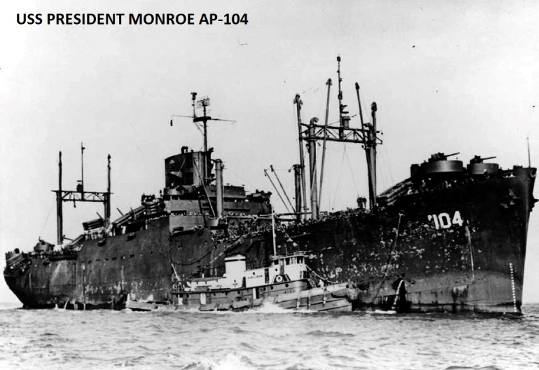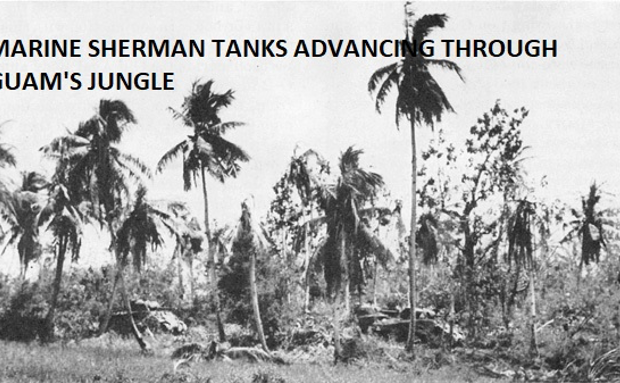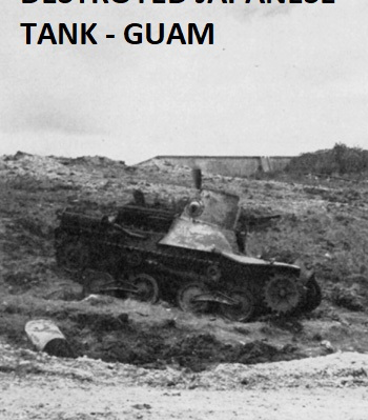Spike Strawn: American Hero
By Todd Blomerth
Special to the LPR
Editor’s note: this is part two of a three part story by Todd Blomerth
On 16 January 1944, Spike and the 2nd Separate Tank Company of the 22nd Marine Regiment boarded the USS President Monroe. After a brief stop at Pearl Harbor (after training on Maui and the Big Island) Spike noted in his pocket notebook that on 23 January he “left Pearl Harbor for the Marshall Islands.” Ten days later, Spike “witnessed my first air and naval bombardment in Marshall Islands.”
The 22nd Marines was part of a large American force attacking the Japanese occupied Marshall Islands in the advance toward the Japanese home islands. Initially held in reserve during the landing on Kwajalein, the 22nd struck Engebi, and after fierce fighting, secured the island. Spike’s notes of 19 February 1944 state: “Landed on next island [Eniwetok] after Army 106th Regiment failed. Much more opposition than expected. So far in all operations 2nd Separate Tank Co. has lost three tanks and 7 or 8 men.” Over 800 Japanese were killed on Eniwetok.
The baptism under fire continued. The island fighting was extremely vicious. The Japanese rarely surrendered. After three days and nights without rest, what Spike describes as “the last island” in Eniwetok Atoll [probably Parry Island] was attacked. The Americans did a better job of softening up Parry than had been done on Eniwetok. After two days, only 105 Japanese of the 1100 defenders survived to be captured. Spike’s tank company lost ten more men killed.
Finally, Spike’s company was put ashore on a small deserted island in the Kwajalein Atoll chain supposedly for “garrison duty” – and immediately forgotten. With little food, the men resorted to stunning fish with hand grenades. Three weeks later, someone finally remembered the bedraggled bunch and pulled them off the island.
Spike’s mail caught up with him. He discovered that his cousin and best friend, Frank Coopwood, Jr. had been killed in the mountains of central Italy on 23 December 1943 while fighting with the 36th “Texas” Division.
In 1995, Spike recorded some recollections of his time in the Marines. One incident of the Marshall Islands stood out. One of the 22nd’s mortar platoons had an undersized and very young Marine. The kid was deeply loved and treated as if he was the platoon’s mascot. During some point in the fighting, Spike recalls the platoon coming off the line, and everyone in it was “bawling like a baby.” The young marine had been killed by a Japanese flamethrower.
After Kwajalein and Eniwetok, the 22nd Marines was shipped to Guadalcanal. for refitting and training for the next landing. Many of the 22nd’s marines had trained in 1942-1943 in American Samoa. Over a thousand men were discovered to be infected with filariasis, a nasty tropical roundworm. Most had to be evacuated.
Not all deaths were combat related. Spike vividly recalled the death of a tanker. During one operation, the Navy “got scared” and let off the marine tanks from its landing craft in “about 80 feet of water.” A marine named Drumgould was in the gunner’s seat when the thirty-three-ton Sherman drove off the ramp and immediately sank. Somehow, Drumgould pushed through an eight-inch opening, and made it to the water’s surface. His ears, nose and mouth bled from the pressure change. The tank driver was trapped when the Sherman settled, blocking his way out. He died, and Spike recalled Dromgould, haunted by the event, “walking, walking all night long.”
The regiment’s strength was rebuilt, and along with the 4th Marines and an Army regiment, formed into the 1st Provisional Marine Brigade. The newly rebuilt regiment trained intensely. The next stop – the island of Guam.
On July 22 July 1944, the Americans began the attack to retake Guam, lost to the Japanese shortly after Pearl Harbor. Guam and nearby Saipan and Tinian could hold airfields within range of the Japanese home islands for the new B-29 bombers. The 1st Provisional Brigade landing was met by ferocious resistance. A beachhead was secured, and then the marines withstood repeated attempts to push them back into the sea. As the tanks landed, Spike spied seven dead marines lying behind a coconut log. All had been killed by a sniper. Spike’s platoon leader, a young lieutenant from Cuero, had predicted he wouldn’t survive. He was right. Within days of the landing, the young officer was killed.
Japanese light tanks were no match for the American’s Shermans. But the Americans’ armor took many losses from suicidal attacks with satchel charges. At night, Spike and other tankers withdrew into the marines’ defensive lines to avoid the enemy’s intense shelling, and sneak attacks.
The island was officially declared “secured” on August 10. By that time, over 11,000 Japanese had been killed. Several thousand fled into the mountainous terrain. . As the mopping up continued, his tank company was tasked with guarding a hospital on the north end of the island. Security was relaxed – there seemed little risk. A young private in the company named Parsons joined a volleyball game nearby – and was shot dead by a sniper. Parsons was one of at least fifteen in the company killed.
The 22nd Marines shipped back to Guadalcanal to refit. Everyone anticipated that the closer to Japan the landings became, the more ferocious the resistance would become. While on Guadalcanal, the 22nd Marines became part of the newly formed 6th Marine Division. Spike’s tank company was designated B Company, 6th Tank Battalion, 22nd Marines.
The next landing – Okinawa. Sixty-six miles long and seven miles wide, it was the largest of the Ryuku Islands and was considered one of Japan’s home islands. Seven American divisions – four Army and three Marine – landed on 1 April 1945 in the largest amphibious landing of the Pacific War. Nearly 200,000 soldiers and marines,supported by the US Navy’s hundreds of warships, splashed ashore and found virtually no resistance.
Where was the enemy? Soon, the Americans found out.







My name is Jay Ingwell and my father(Sgt.Vivian Ingwell) served with the 2nd Separate Tank Company during WWII. I’ve been researching my father’s service and the history of the 2nd Separate Tank Company for the past few years and would be interested in contacting the author of this series (Todd Blomerth) and especially Mr. Strawn.